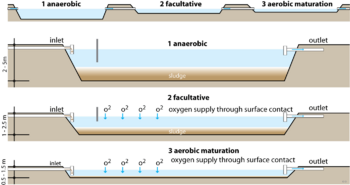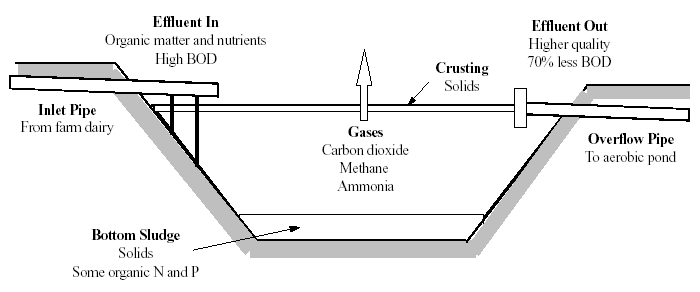

Waste Stablinzation Ponds
Multi-cell WSP system comprises of three types of ponds
- Anaerobic ponds
- Facultative ponds and
- Maturation ponds.
Usually a WSP system comprises a single series of the aforementioned three ponds types or several such series in parallel. Anaerobic and facultative ponds are designed for BOO removal and maturation ponds are designed for pathogen removal; although some BOO removal occurs in maturation ponds and some pathogen removal in anaerobic and facultative ponds. In many instances only anaerobic and facultative ponds are required. In general, maturation ponds are required only when stronger waste waters with BOD greater than 350 mg/ L are to be treated prior to surface water discharge and when the treated waste water is to be used for unrestricted irrigation. Generally, in WSP systems, effluent flows from the anaerobic pond to the facultative pond and finally, if necessary, to the maturation pond. However, for better results waste water flowing into an anaerobic pond shall be preliminary treated in order to remove coarse solids and other large materials often found in raw waste water. Preliminary treatment includes coarse screening, grit removal and, in some cases, comminution of large objects.
Two or more small lagoons can often provide better quality treatment than one large lagoon. In systems that employ more than one lagoon, each lagoon cell has a different function to perform and a different kind of lagoon design may be used for each cell.
In Series When lagoons operate in series, more of the solid material in the waste water, inches algae, has an opportunity to settle out before the effluent is disposed of. Sometimes serial treatment is necessary so the effluent from lagoon systems can meet local requirements.
- Single Ponds system of WSP
- Multiple Ponds System of WSP – Series
- Multiple Ponds System of WSP – Parallel
A – Anaerobic pond, F – Facultative pond, M – Maturation pond
Process flow diagram of pond system
Parallel Ponds: In parallel means that a system has more than one cell that is receiving wastewater at the same stage of treatment. This system design is particularly useful in cold climates. Because biological processes are involved, waste water treatment slows down in cold temperatures, making treatment less efficient. Parallel cells are often used during winter months to handle extra loads.
Anaerobic Ponds Anaerobic ponds act like uncovered septic tanks. The anaerobic ponds are deep treatment ponds that exclude oxygen and encourage the growth of anaerobic bacteria. Anaerobic bacteria degrade organic materials in the absence of O2 ( oxygen ) and produce CH4 (methane ) & CO2 (carbon dioxide). The methane can be reused as an alternative energy source (bingos). Other benefits include a reduction of total bin-solids volume of up 10 50-80% and a final waste sludge that is biologically stable can serve as rich humus for agriculture Sludge is deposited on the bottom and a crust forms on the surface as shown in Fig
Anaerobic ponds are commonly 2.0 – 5.0 m deep and receive a high organic loading (usually > 100 g BOD/m /d equivalent to > 3000 kg/ha/ d for a depth of 3m). Anaerobic ponds don’t contain algae, although occasionally a thin film of mainly Chlamydomonas can be seen at the surface. They work extremely well in warm climate and have relatively short retention time (one day is sufficient at temperature > 20°C) for a BOD of up to 300 mg/L.
Anaerobic ponds reduce nutrients and pathogenic microorganisms by sludge formation and the release of ammonia into the air. As a complete process, the anaerobic pond serves to:
- Separate out solid from dissolved material as solids settle as bottom sludge.
- Dissolve further organic material.
- Break down biodegradable organic material.
- Store undigested material and non-degradable solids as bottom sludge.
- Allow partially treated effluent to pass out
This is a very cost-effective method of reducing BOD,. Normally, a single anaerobic pond in each treatment train is sufficient if the strength of the in-fluent waste water is less than 1000 mg/L of BOD. For high strength industrial wastes, upon three anaerobic ponds in series might be justifiable but the retention time mans’ of these ponds should not be less than one day.
One Response to “Waste Stablinzation Ponds”
Leave a Reply








 LIKE TO GET UPDATES
LIKE TO GET UPDATES  TO GET EXPERT GUIDE
TO GET EXPERT GUIDE
please kindly help me with a laboratory model of a maturation pond (drawing)